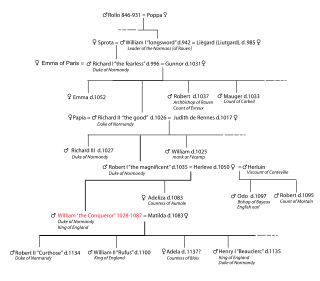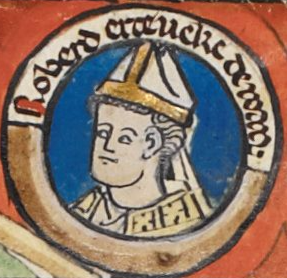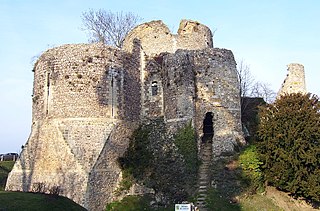
Normandy is the northwesternmost of the 18 regions of France, roughly coextensive with the historical Duchy of Normandy.
William I, usually known as William the Conqueror and sometimes William the Bastard, was the first Norman King of England, reigning from 1066 until his death in 1087. He was a descendant of Rollo and was Duke of Normandy from 1035 onward. His hold was secure on Normandy by 1060, following a long struggle to establish his throne, and he launched the Norman conquest of England six years later. The rest of his life was marked by struggles to consolidate his hold over England and his continental lands, and by difficulties with his eldest son, Robert Curthose.
Rollo was a Viking who became the first ruler of Normandy, a region in northern France. He emerged as the outstanding warrior among the Norsemen who had secured a permanent foothold on Frankish soil in the valley of the lower Seine. After the Siege of Chartres in 911, Charles the Simple, the king of West Francia, gifted them lands between the mouth of the Seine and what is now Rouen in exchange for Rollo agreeing to end his brigandage, swearing allegiance to him, religious conversion and a pledge to defend the Seine's estuary from viking raiders.
William of Poitiers was a Frankish priest of Norman origin and chaplain of Duke William of Normandy, for whom he chronicled the Norman Conquest of England in his Gesta Willelmi ducis Normannorum et regis Anglorum or Gesta Guillelmi II ducis Normannorum. He had trained as a soldier before taking holy orders.

The Anglo-Normans were the medieval ruling class in England, composed mainly of a combination of ethnic Anglo-Saxons, Normans, Bretons, Flemings, Gascons and French, following the Norman conquest. A small number of Normans had earlier befriended future Anglo-Saxon King of England, Edward the Confessor, during his exile in his mother's homeland of Normandy. When he returned to England some of them went with him, and so there were Normans already settled in England prior to the conquest. Following the death of Edward, the powerful Anglo-Saxon noble, Harold Godwinson, acceded to the English throne until his defeat by William, Duke of Normandy at the Battle of Hastings.

Robert the Magnificent, was the duke of Normandy from 1027 until his death in 1035.

The Duchy of Normandy grew out of the 911 Treaty of Saint-Clair-sur-Epte between King Charles III of West Francia and the Viking leader Rollo. The duchy was named for its inhabitants, the Normans.

In the Middle Ages, the Duke of Normandy was the ruler of the Duchy of Normandy in north-western France. The duchy arose out of a grant of land to the Viking leader Rollo by the French king Charles III in 911. In 924 and again in 933, Normandy was expanded by royal grant. Rollo's male-line descendants continued to rule it down to 1135. In 1202 the French king Philip II declared Normandy a forfeited fief and by 1204 his army had conquered it. It remained a French royal province thereafter, still called the Duchy of Normandy, but only occasionally granted to a duke of the royal house as an apanage.

Odo of Rennes, Count of Penthièvre, was the youngest of the three sons of Duke Geoffrey I of Brittany and Hawise of Normandy, daughter of Richard I of Normandy. Eudon married Agnes of Cornouaille, the daughter of Alan Canhiart, Count of Cornouaille and sister of Hoel II, Duke of Brittany who was married in 1066 to Eudon's niece Hawise, Duchess of Brittany.

Robert II or Robert the Dane, Archbishop of Rouen, and Count of Évreux was a powerful and influential prelate, and a family member of and supporter of five dukes of Normandy.
William Longsword was the second ruler of Normandy, from 927 until his assassination in 942.

William the Conqueror had men of diverse standing and origins under his command at the Battle of Hastings in 1066. With these and other men he went on in the five succeeding years to conduct the Harrying of the North and complete the Norman conquest of England.
Raoul II de Tosny seigneur de Conches-en-Ouche was a Norman nobleman of the House of Tosny, son of Roger I of Tosny and older brother of Robert de Stafford / Tosny. He was active in Normandy, England and Wales.
Robert de Stafford was an Anglo-Norman nobleman, the first feudal baron of Stafford in Staffordshire in England, where he built as his seat Stafford Castle. His many landholdings are listed in the Domesday Book of 1086.
Humphreyde Vieilles was the first holder of the "grand honneur" of Beaumont-le-Roger, one of the most important groups of domains in eastern Normandy and the founder of the House of Beaumont. He was married to Albreda or Alberée de la Haye Auberie.

Roger I of Tosny or Roger of Hispania was a Norman nobleman of the House of Tosny who took part in the Reconquista of Iberia.

The House of Tosny was an important noble family in 10th and 11th century Normandy, though it did not include any comtes or vicomtes. Its founder was Raoul I of Tosny.
Raoul III of Tosny (1079-1126), Lord of Conches-en-Ouche, was an Anglo-Norman nobleman of the House of Tosny.

The Normans are an ethnic group that arose from contact between Norse Viking settlers of a region in France, named Normandy after them, and indigenous Franks and Gallo-Romans. The settlements in France followed a series of raids on the French coast mainly from Denmark — although some came from Norway and Sweden as well — and gained political legitimacy when the Viking leader Rollo agreed to swear fealty to King Charles III of West Francia following the Siege of Chartres in 911 AD. The intermingling of Norse settlers and native Franks and Gallo-Romans in Normandy produced an ethnic and cultural "Norman" identity in the first half of the 10th century, an identity which continued to evolve over the centuries.
The Laigle family was a Norman family that derived from the town of L'Aigle, on the southeastern borders of the Duchy of Normandy. They first appear during the rule of Duke Richard II of Normandy, in the early 11th century, and they would hold L'Aigle for the Norman Dukes and Kings of England until the first half of the 13th century, when with the fall of Normandy to the French crown the last of the line was forced to abandon the ancestral French lands, only to die in England a few years later without surviving English heirs. Their position on the borderlands, and near the headwaters of three rivers, the Risle, Iton and Avre, gave their small holding a special importance, as did a set of marriage connections that provided this relatively minor Norman noble family with a more elevated historical visibility. Having been neighbors and benefactors of the Abbey of Saint-Evroul, the family receive mostly-favourable coverage in the 12th century chronicle of Orderic Vitalis.










